
The Dennis 4-ton buses for London Bus Companies
This page created 14th February 2020 using Wordpad, by Ian Smith.
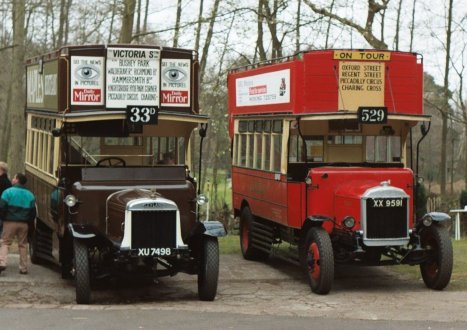 For operators seeking to start up double-decker operations in London in the early 1920s there was a choice of buses:
Daimler Y-type, Straker Squire, Thorneycroft J, Leyland LB or Dennis 4-ton. All had to have bodywork approved by the Metropolitan Police.
The Straker Squires were initially popular, but soon fell from favour,
leaving the Dennis 4-tonner and the Leyland LB as the popular choice,
either fitted with 26up, 22down seater bodies, mainly by Dodson, who offered sweetheart deals to new starters, but also by Strachan & Brown, Birch, Wilton or Hickman. Open tops, open staircases, open cabs and solid tyres and were the orders of the day, of course. They were competing with hordes of General's B-types, which suddenly appeared antiquated in comparison, and General's new K-types.
For operators seeking to start up double-decker operations in London in the early 1920s there was a choice of buses:
Daimler Y-type, Straker Squire, Thorneycroft J, Leyland LB or Dennis 4-ton. All had to have bodywork approved by the Metropolitan Police.
The Straker Squires were initially popular, but soon fell from favour,
leaving the Dennis 4-tonner and the Leyland LB as the popular choice,
either fitted with 26up, 22down seater bodies, mainly by Dodson, who offered sweetheart deals to new starters, but also by Strachan & Brown, Birch, Wilton or Hickman. Open tops, open staircases, open cabs and solid tyres and were the orders of the day, of course. They were competing with hordes of General's B-types, which suddenly appeared antiquated in comparison, and General's new K-types.
Two of the most popular 1920s buys for Independent bus operators: the Leyland LB and the Dennis 4-ton, in preservation at Cobham Bus Museum's Open Day in 2003.Premier Omnibus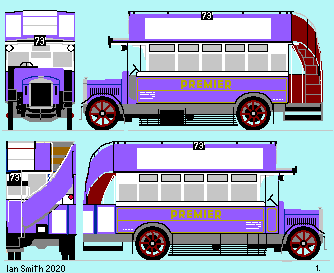 Premier started operations from Cricklewood in March 1923 with three Straker Squires (standing in for delayed Leylands). Two LBs quickly followed, and then four Dennises in September/October, with five more in early 1924, displacing the Straker Squires. Bodywork was by Dodson. The mauve and white buses were used wherever there was a profit to be made. They appeared on the 6,9,12,33,51,73 and 142 in the early days, settling on the lucrative 11, 18,60 and 73 before the 1924 Act regulated their activities. Their base moved to Shepherd's Bush. Premier stayed in operation despite the blandishments of the General until taken over by London Transport in 1933.
Premier started operations from Cricklewood in March 1923 with three Straker Squires (standing in for delayed Leylands). Two LBs quickly followed, and then four Dennises in September/October, with five more in early 1924, displacing the Straker Squires. Bodywork was by Dodson. The mauve and white buses were used wherever there was a profit to be made. They appeared on the 6,9,12,33,51,73 and 142 in the early days, settling on the lucrative 11, 18,60 and 73 before the 1924 Act regulated their activities. Their base moved to Shepherd's Bush. Premier stayed in operation despite the blandishments of the General until taken over by London Transport in 1933.
OvergroundOverground was the fleet name applied to buses by Walter Dangerfield, consciously relating it to the Combine's Underground. Livery too was red and white, like the General. These settled after the 1924 Act on the 284A between Hadley Highstone and Victoria. Dangerfield also managed Carlton on their own route 4 - later 285 - (Muswell Hill to Victoria). That company added Dennises to their LBs, and operated on 24,27,28, 29 and 31 as well, and following Overground's success adopted their red and white and fleetname.Many Small Independents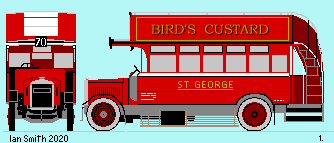
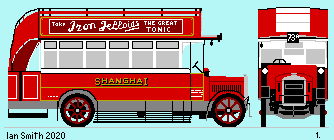
Many other small companies started up with Dennises during 1923 and 1924. People from all kinds of businesses saw an opportunity for a quick profit in providing motor buses. Some were people with experience in the bus industry. Some had driven during the Great War. But all kinds of entrepreneurs jumped on the band-wagon. Most were one-bus or two bus concerns. Some had a few more. Most buses were bought on hire purchase from the body builders, who were not happy with the stranglehold held by the General on London bus building. So the buses crammed in, looking for lucrative routes, which were often those in Central London. Buses were often licensed for a multiplicity of routes, switching from one to another according to the time of day and the perceived traffic flows. Competition was fierce, and not always friendly. At first the new buses were in a variety of liveries, flaunting their independence, but many others recognised that painting their buses like those of the General (red/white or red/cream) could gull waiting passegers into riding with them instead! The London Traffic Act 1924This Act was in response to the proliferation of operators in Central London. Some were responsible, others not. The Act required all operators to register their routes for weekdays. Buses were licensed for use on published schedules. These might incorporate more than one route, but buses were required to keep to their schedules. These could not be swapped between operators. Sundays remained a free-for-all, and many operators switched that day to lucrative recreational traffic instead of the commuter runs. The Police Commissioner then required all routes, including all short workings, to be given a distinctive number - the Bassom system. This in particular made many of the independent route-chasers uneconomic. Some gave up. Others formed Associations to operate specific Independent routes. There were complaints that the Traffic Commissioners were unduly swayed to favouring the General. Some roads were Restricted, limiting the number of buses. This applied especially to tram routes, even when a legal judgement ruled that taking competition with trams into consideration was unlawful - not within the scope of the Act. Some operators found remunerative routes in the expanding suburbs around London, where Restrictive Street Orders had not yet arrived, and in the outer areas beyond the Metropolitan Police boundary, where operators had the local Traffic Commissioners and Watch Committees to satisfy instead.TakeoversSome minnows found the bureaucracy of the Bassom system not to their taste, and formed legal companies to sell their vehicles and associated schedules. Others were taken over by larger groupings. General bought some larger companies too: Cambrian, which had four Dennises amongst its 52 buses, was taken into LGOC operation in early 1926, although it kept its fleetname. Many many other small operators were acquired in 1927.
PublicThe London Public Omnibus company was set up ostensibly to protect the independent sector. Many small, and not so small operators sold up to them when they would not have sold to the LGOC. Most did not know that the company was underpinned by the General. 77 operators came into the Public fold, including the large fleet of Admiral. All was revealed in spring 1928 when LGOC formally bought the LPOC. Public continued to operate under their fleet name, but in February 1929 did a major swap of routes and schedules to concentrate its activities on its garages at West Green and Enfield. Some of the public awoke to find that their journeys on pneumatically tyred Dennises had been replaced by solid tyred K-types!
By 1928 the surviving Dennis 4-tonners were almost all on pneumatic tyres. This allowed the maximum allowable speed to go up from 12 to 20mph. Useful when competing with the General's K-types and S-types! But the Titans of other Independents were serious opposition, and the General was soon to re-equip with seriously more modern ST types. London TransportLGOC, although having taken over many Dennises, had disposed of all of them before the London Passenger Transport Board took over in 1933. Now London Transport mopped up the small operators within its patch, numbering their acquired Dennises into a D-series, which initially included all kinds of buses, both single deck and double-deck, enormous and tiny. The 4-tonners were renumbered, or numbered on acquisition, into a series between D175 and D201, filling in the gaps left when other types were renumbered into different series: DS, DE, DH, DM... They were all slated for early disposal, and went during 1934 and 1935.PreservationD142 was a Dodson-bodied 4-tonner built in April 1925 for the Dominion Bus Company. It had been taken over by the LGOC in March 1926, and given number D22. After overhaul and body swap it was allocated to Redburn's (a LGOC subsidiary). After another spell with LGOC it was allocated to Public, who numbered it D142 and used it from West Green garage on the 529 (Winchmore Hill - Pimlico). Public moved it to Enfield garage (also supplied by LGOC). It received other new bodies at overhauls in 1930 and 1931, and at some stage received pneumatic tyres. It was also used in its latter days from Hounslow and Hackney garages, before withdrawal from service in December 1931 and sale. Forty years later it was uncovered in Wickford, Essex, covered in corrugated iron sheeting which had largely protected it. A group led by Mr Prince Marshall restored it it to magnificent working condition. In 1972 it went on tour in Japan, for English Tourist Board, before touring the UK Back at headquarters in the old Nunhead garage it was prepared for use on the London Sightseeing Tour on route 100, to and from the London Transport Museum in Covent Garden. In 1984 it was acquired by the London Bus Preservation Trust at Cobham Bus Museum, from where it made forays to various rallies and road runs. I met it one day in June 2001, when it was guest of honour at the opening of a new Bus Lane across Kingston Bridge. I was fortunate enough to be invited for a ride as it headed back towards Cobham, and enjoyed the sunshine on top along to Hampton Court. The Cobham Museum moved to Brooklands in 2012, as the London Bus Museum, and D142 took up residence there.D142 was guest of honour when a new bus lane was opened on Kingston Bridge in June 2001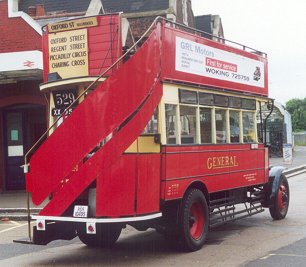
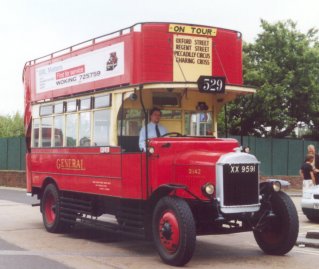
|

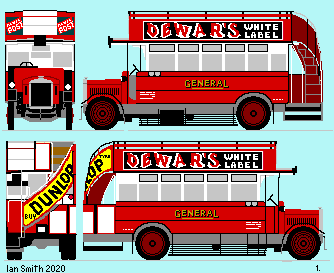
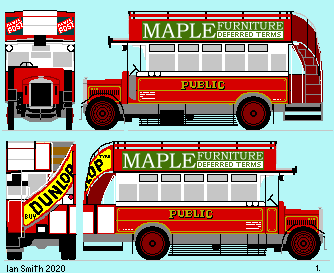
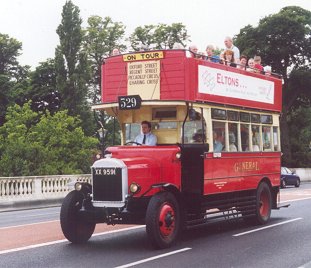
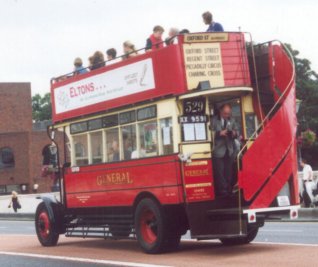
 Ian's Bus Stop
Ian's Bus Stop D main text.
D main text. D histories
D histories